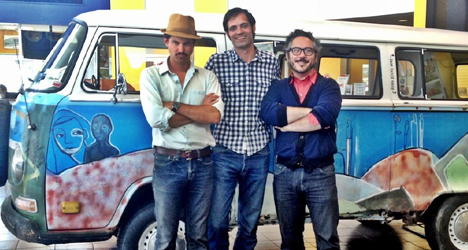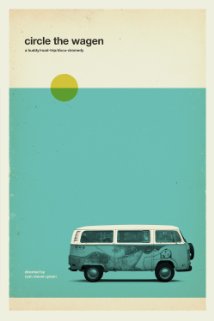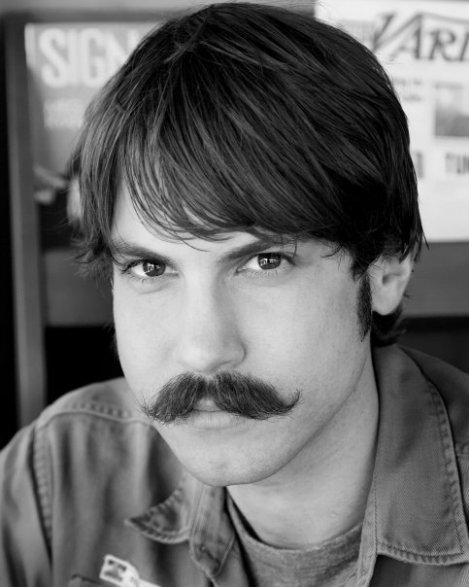
Ryan Steven Green is a producer, editor, and documentarian. His newest film, the road-trip documentary Circle the Wagen, traces the four-year-long trials of Dave Torstenson and Charlie Pecoraro as they attempt to bring “The Croc” – an aging vintage Volkswagen van – cross-country to California. Circle the Wagen had its World Premiere at the 2013 Albuquerque Film & Media Experience and was an Official Selection of the 2013 Austin Film Festival. On February 21, 2014, the film will have a by-request additional screening in Austin. Ryan Steven Green spoke with Sean Malin of CineMalin: Film Commentary and Criticism about producing the film with decade-long friends Mr. Pecoraro and Mr. Torstenson, the art of telling the nonfiction story, and what VW owners know that the rest of us don’t. This interview has been transcribed, edited, and compressed from audio for publication.
*****
Sean Malin: You premiered Circle the Wagen in a pretty unorthodox setting: an arts festival in Albuquerque, rather than a film festival.
Ryan Steven Green: We showed it for the first time at the Albuquerque Film & Media Experience, which is film-centric but includes art, dance, and a bunch of different media. It’s interdisciplinary for sure, though I expected more music.
Sean Malin: Did you expect your film to play better to that kind of audience than the staunch cinephiles that attend film-exclusive festivals?
RSG: Oh, yes. When we had just finished the film, I thought, “this is not going to be the kind of movie critics like – it’ll be the kind of movie people like.” That’s proven not to be true, however, at AFF or in Albuquerque because we have yet to receive a real pan, so if you could help me out with that…*Laughs* Circle the Wagen is kind of like a teddy bear, you can almost hold it.
SM: Let’s not get confused here: is the movie the teddy bear, or is Dave Torstenson, your central character, what people find so sweet and likable?
RSG: I have a theory that if you don’t like Dave, you don’t like the film – even though there are some sweet Volkswagens in it, the appeal of the cars won’t last an hour-and-a-half. Not that there’s not style to the movie, which there certainly is, but Dave is everything to the movie.
SM: The fact that you, [executive producer] Charlie Pecoraro, and Dave are such friends makes the finished product almost look too easy, like you just went out and got camera people and a sound guy. I know that that’s not literally true, but when you set out to make the film, did it ever feel like too much of an inside joke between you guys, or too insular a project?
RSG: Not really because I edit my own films and I have no problem cutting scenes, cutting time, cutting Dave out *laughs*. Right before I submitted the cut of the film to [Austin Film Festival], I was cutting off another two minutes. I’ve been making movies like this since I was about fourteen years old, and what’s crazy is that not much has changed since then. Yes, I’m more assured and I know a little bit more of what to expect in the end, but it’s never easy. I’ve also worked as a photographer for newspapers and as a journalist, and when you do that, you learn that behind the camera is actually the loneliest place on earth. You’re standing there “with” people, but you’re not there, you know? Even when it’s my friends onscreen, I still feel like I need to take a respectful distance through this tiny little frame.
SM: Which came first for you: wanting to make a movie with your good friends, or a fascination with the national Volkswagen community?
RSG: Neither came first – the movie never would have happened if Dave hadn’t bought “The Croc” and, as I later heard, failed to bring it back to California. As you see in the film, Dave is a natural traveler, so when he got back [to L.A.,] he and Charlie started talking about going right back out to get the bus. They said to each other, “We know a sap with a camera…” and within a month, we were raising money to get a crew together and rent an RV. By the end of that month, we were on the road shooting Circle the Wagen.

SM: How long was that first road-trip, actually? It’s compressed to just a few minutes of screen-time.
RSG: The first was scheduled for two weeks; it lasted about nine days. At that point, only about a third of the way home on Route 66, we considered towing the VW all the way back. But the game changed when Bill Kinder [who appears in the film] offered to keep the bus at his hotel. That allowed us to get back – everyone on that trip had jobs, and we were out of money – and pick up where we left off at a later date.
SM: No one in the movie seems remotely suspicious of Mr. Kinder’s offer to hold on to The Croc. To me, the owner of a hand-me-down car not nearly as cool as Dave’s, it would still seem like a scary proposition if someone offered the same for my car.
RSG: Without that offer, we would not have all been able to get home at that time. You can see in that scene when Bill tells Dave and Charlie that he’ll keep the VW for a bit how relieved they are. At that point, we weren’t thinking much further in advance than, “How are we going to make it back?”
SM: After that scene, there’s a line of dialogue that indicates it’s been nearly four years. And you shot in that four years in a variety of places just to keep this project going. Was there ever a point where the film was nearly scuttled?
RSG: The backstory of that four years had [us] all over. You see in the film that Dave was traveling and teaching all over the world during that time. He’s a real person who needed to live his life, and we never wanted to lasso him and say, “Hey, sorry, but you need to start living your life as it applies to our movie.” In between shoots, I got married and kept developing my career as a commercials director and filmmaker. Charlie kept plugging away as an actor in Los Angeles. But none of us ever abandoned hope that this project would happen. There was even some light shooting sprinkled in too: we shot at the L.A. Auto Show, for example, and at some Southern California Volkswagen shows, though some of that footage didn’t make it to the film.

SM: I was raised right outside Los Angeles, which meant that in high school, I needed a car to get around. The first car I ever received was a huge ‘97 Mazda MPV that got 20 miles to the gallon. I remember barely making it at thirty-miles-an-hour up the Pacific Coast Highway to Monterey Bay in six or seven horrible, fearful hours. Though I didn’t break down, I remember just scary the car became taking curves or driving uphill or on dirt roads. Circle the Wagen does not have many frightening scenes except for one in which, during a break-down, Dave gets covered in burning gasoline. How present was the element of fear that comes with driving old, hazardous cars while you were shooting?
RSG: As a society, we’ve absolutely lost touch with the road and our vehicles: you get in your air-conditioned car, blast the radio, smoke your cigarette out the open window. There’s the fact that you can drive 100 miles-an-hour and the car doesn’t so much as shake. Let me give you some salient facts about driving from the perspective of someone who drives a ’67 Squareback and has for seven years. Driving the Squareback from Pasadena to Santa Monica is like crossing the country in a covered wagon. You do not pass anyone; you feel every crack, every bump, and every cigarette butt thrown out a window. It has been an education for me, to say the least. When you see a map that says, “Tulsa to Tucumcari, New Mexico – 500 miles,” a modern-car driver might say, “that’s not so bad – why did it take the guys nine days to make that trip?” Oh my goodness! Try walking 500 miles and then try walking 500 more and living. That’s a long way for vehicles that are not modern, like these VWs. Some other instances come to my mind, like them breaking down at night and being caught on the two-lane portion of the freeway trying to make calls. It is downright dangerous: cars are like missiles, they’re death machines.
SM: And yet it’s those machines that form the thru-lines for empathy in your film. Not only does Dave refer to his heroic car as, “The Croc,” but he refers to it as, “she” and has an instinctual kind of relationship with it. At one point he says, “I can just feel that something’s wrong.”
RSG: [The Squareback’s] name is Wendy. I got her two months before my wedding, and of course we drove away from the ceremony in it.
SM: Now, so many years later, Circle the Wagen is finally finished. What projects are you working on currently?
RSG: Do you know the names Billy Barty and Jerry Maren?
SM: I’m afraid not.
RSG: Billy Barty was a dwarf actor who was a huge advocate for the dwarf community for many, many years. He was an entertainer, but he was also an outspoken public figure and contributed to innumerable organizations including the Little People of America, which he founded in 1957. Jerry, who was also in countless films and televisions shows like Billy, is probably most famous for being the only surviving Munchkin cast member – at 94-years-old! – of The Wizard of Oz (1939.) Well, in the 1940s, Billy and Jerry started a softball team called The Hollywood Shorties. Every year for awhile, there was an informal get-together and softball game in Los Angeles to raise charity. It became more sporadic over time until the 1970s, when basketball was becoming quite popular. Maren and Barty, who were getting older, passed coaching duties of a new, professional basketball team onto a man named George Rossitto. They start playing charity events, school fundraisers, and all-star Hollywood games until they become so popular that they start playing Lakers games – against the Laker Girls! By the mid-1980s, they were living the Hollywood dream, but you can’t find anything online on them for one reason or another. But I don’t intend for this to become a film about dwarfism: The Hollywood Shorties (2014) is a documentary about a basketball team’s rise-and-fall.
SM: I like that you specified that. What is Circle the Wagen really about, if I may ask?
RSG: Circle the Wagen is a movie about strangers helping strangers and good old common kindness. There’s an argument to be made that it’s a story about the life of Dave Torstenson…
SM: But with four years missing in that life, that can’t really be accurate, can it?
RSG: I think it could be accurate because he’s a different person at the end than he is at the beginning, but it feels to me like community is the soul of the film.

